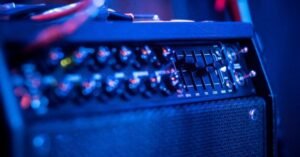Buying guitar gear to motivate yourself
Learning is self-driven, but it needs to be supported with aims to keep the learner engaged. The guitar is a fantastic way to express creativity and a love of art. When it comes to playing the guitar, motivation is essential. Not every person has the same innate aptitude or passion for music.
Buying guitar gear to motivate yourself is a fabulous way to inspire your venture. You need the proper gear to sound excellent on the guitar and advance. A brand-new equipment item can convince you. A new guitar or amp will sound and play way different, which may motivate you to shift how you play.
This article gives you an idea of what goes into buying guitar gear and how you can use it as a motivator for yourself.
Buying guitar gear to motivate yourself
Motivation can be tough to overcome when you’re struggling through a tough practice session or competition. But you can do a few things to boost your morale, even if you don’t have enough musical talent. It may lower your self-efficacy. You are attempting to capture the tone or sound of the piece you are performing. Gear is one of the critical elements which strengthens your resolve to learn and determines your progress. Buying guitar gear to motivate yourself is a practical idea.
Playing on equipment that suits your style and ear is fascinating. For some folks, having a more excellent setup inspires them to work harder on their projects. Another factor that drives us to purchase equipment is when we observe our favorite artists trying it.
Naturally, you don’t wish to squander, but the brand-new item can influence you to grab your instrument again. It stimulates pleasing sensations.
Fortunately, there are plenty of ways to get the gear you need without breaking the bank. Below are some recommendations for choosing the best gear and getting the right tones for your favorite styles of music.
Guitar selection
If you intend to achieve your best abilities, you must have a guitar that you can handle confidently and appropriately tuned so that it sounds nice overall. Selecting the right guitar is relevant for both beginner and experienced players.

How to choose a guitar
Choosing the right guitar can be daunting, but there are a few things to remember when shopping. There are a few things that help you make an informed decision. The size, tone, and style decide which guitar fits you.
First and foremost, size is an essential factor. You don’t want to buy an instrument that’s too large or small for your hands. Consider the size of the guitar. Do you want something small, portable, or more significant to sit comfortably on your lap?
Second, consider your playing style. Do you want a traditional acoustic or an electric guitar? Acoustic guitars are best for classical or folk music, while electric guitars are better for rock and blues music. Your budget is the first thing you need to determine when choosing an acoustic guitar. Fortunately, you don’t need to spend much money to get a quality instrument. Next, when it comes to acoustic guitar specs, there is nothing specific you need to look for. Choosing a guitar that feels comfortable in your hands and sounds pleasant to your ears would be best.
Acoustic guitars are typically more challenging to play than electric guitars. The pickups and pickup configuration should be prioritized when deciding whether to purchase an electric guitar. Guitar pickups can be divided into two primary groups: single-coils and humbuckers. A rock enthusiast may not buy a guitar designed for country music. Your decision depends on the type of music you intend to play.
Third, search for attributes that are significant to you. Do you prefer an electric or solid-body guitar? Analyze your playing style first. Are you interested in a heavy or light guitar? If you primarily use clear tones, choose a heavier option. If you enjoy adding distortion and crunch to your sound, select a lighter guitar that can withstand more noise.
Fourth, be prepared to spend some money on a high-quality instrument. A guitar’s price tag does not always indicate its quality or sound. A high-end model can cost well over $1,000, but you can buy an excellent guitar for under $100. Finding a guitar that meets your budget and needs is crucial.
Don’t overlook the tools and resources available online to help you find a suitable guitar. If you’re on a tight budget, don’t be hesitant to look for used guitars and amps on Craigslist or eBay. You may be surprised at what you can find – and the prices aren’t always bad!
The time you invest in practice is more important than the money you spend on a guitar. Choose a guitar that you love picking up frequently and playing a lot. It feels good, inspires you, and then focuses all your attention on playing it. Your objective should be to improve your guitar playing instead of looking for a guitar. Before purchasing, don’t be reluctant to test various models in stores or online. Play a variety of guitars and choose the one that appeals to you the most.
How to test a guitar
Anyone can play the guitar with some fundamental skills. It has many features, such as different string lengths, tunings, etc. Testing a guitar is vital to ensure the instrument sounds and plays correctly. However, like any other equipment, it can also be prone to malfunctions. Here are some pointers to aid you in putting a guitar through its paces:
Check the strings for damage. Ensure all the strings are in good condition and ring out clearly when plucked. Strum the strings several times to make sure they sound normal. If one or more strings are noticeably bowstring-y or stretched, it may be necessary to replace them. Get a new guitar if the strings are clearly damaged.
One way to test a guitar is to play it through an amplifier and see if the sound is distorted or not. If the guitar is plugged in, play each string with one finger and listen to the sound it produces. Test all six strings. The string that produces the loudest sound is usually in the “4th” or “5th” position. To test a guitar’s tone, hold one of the open strings and string the other five strings together. The string that sounds harshest will be in the “3rd” or “4th” position. Buzzing or rattling sounds usually indicate problems with the strings or bridge. If there’s excessive noise, it might be time to replace the components.
Another way is to play it unplugged and see if the strings buzz or not. Press each string down one fret at a time and listen to the sound it produces.
The tone is one of the most critical factors in guitars. The frequency at which a string vibrates affects its sound. The tone can make playing difficult and even frustrating if the tone is off. Strings tuned higher tend to produce brighter tones, while those tuned lower produce warmer sounds. Try adjusting the tuning of your strings to see if this changes the sound of your guitar.
Listen to different tones and chords played on the instrument and compare them to those you know from recordings or other guitars you’ve played in the past. Ensure that each string sounds at its correct pitch and that no high or low notes are missed.
Check the tuning by reading the notes on the neck of the guitar. Inspect the tuning pegs. Please make sure they’re tight and level in the neck. If they appear bent or twisted, it may be necessary to replace them.
If the guitar has any problems, take it to a professional for repairs or testing.
Setting up your guitar
No matter what kind of guitar you select, be careful to give it a correct setup. You can make various tweaks to configure your guitar for the best playing experience. This is a setup process. The ease of playing your guitar, especially while moving around the fretboard and fingering barre chords, can be significantly improved with a suitable setup. You must set up your guitar correctly to fret notes with the least amount of force and with the least amount of noise.
The metal truss rod that runs along the inside of your guitar neck must also be adjusted as part of the setup. The degree of the bow in the neck can be altered using the truss rod.
Picking a guitar amplifier while buying guitar gear to motivate yourself

The amplifier is among the most important gear you may admire. When creating a decent sound, the instrument and the amplifier you put in are equally important. The amp you select will also significantly impact how often you play. It enhances the productivity of the practice sessions.
The size of the amplifier rests on the place where you commonly practice. For instance, if you spend most of your time practicing at home, you require a small, low-powered amp you can use to play at a cozy bedroom volume. You must be able to hear every instrument you play along with during practice sessions to get the most out of your time. Pay close attention to the drums and bass to keep in time with the music and engage in the groove.
Thus, picking a proper guitar amplifier while buying guitar gear to motivate yourself helps you yield desirable outcomes. Avoid using powerful amps designed for use on a big stage. You don’t need to splurge on this, but you require something to keep you motivated.
Effects pedals, often known as guitar pedals or stompboxes, are little electrical devices that modify the sound of your guitar in a particular way. Pedals create special effects like delay, tremolo, wah-wah, chorus, flanger, distortion, and fuzz. They can be as simple as a single effect that gives your sound layers or as an extensive network of pedals connected between the guitar and the amplifier, altering your sound in various ways. But there are other easy, inexpensive, and practical ways to follow which can motivate you to play guitar and upgrade your musical journey.
Planning your practice and track your progress
A more extraordinary setup virtually never prevents a musician from being the best they can be. But you won’t be an expert just because of better equipment. The value of a practice is much greater.
We can create music for artistic enjoyment without ever considering the possibility of transmitting a message. Remember that just sitting down and playing the guitar is not practicing. It’s fun, and occasionally, it can be essential to sit and jam out on well-known songs and possibly some brand-new ones on your guitar. You can arrange your thoughts and give direction or purpose to your musical activities by attempting to express a message, a concept, or a feeling – this will already be a way of eliminating the blank page block and getting you going. While it is always best to make practice sessions enjoyable, you might be overly easy on yourself if they are never dull or stressful. So, before you compose, it is wise to create a plan that you may adhere to or even ignore if necessary.
Ensure that your playtime is organized and well-planned. A schedule will make it easier for you to follow it and prevent burnout. Finally, remember that practice makes perfect – so don’t give up on your learning too quickly!
Every practice begins with a warm-up, which is the ideal moment to mix in scales. An excellent method to get ready for additional guitar practice is to do a scale with a modest tempo increase. When that happens, it’s usually preferred to have a guitar scale reference. Always notice your posture and positioning when starting to practice. Select a scale or a mode, then play with all four fingers.
It would help if you focused on chords and how they relate to one another. In the early stages, you will just be picking up a new chord or two. As you improve, you’ll master barre chords, inversions, fundamentals of music theory, and chord structure. You can also focus on mastering a piece of music you’ve been hoping to perform for a long time.
Write down anything you plan to include in your regimen. Maintain a journal; since you won’t recall everything, practicing will help you repeat positive actions and fix errors. Simply write, erase, and adjust in your journal. It also infuses self-discipline in life in general. Additionally, you need to record which exercise portions were most successful.
At this point, everything should be viewed as guidelines, as only your artistic sense prevails.
Focus on music theory learning
One prevalent misconception about learning an instrument is that it takes practice to become proficient. It’s essential to note the rules that govern how sounds are expressed and the principles that underpin musical communication.
Music theory helps you comprehend how music functions. Studying music theory is similar to learning a language in that it helps us comprehend the shape and structure of a piece of music.
Learning music theory gives you the skills to compose your music. You can communicate your ideas, thoughts, and feelings through music. From this aspect, learning music theory helps you be more creative. It allows you to establish your style concerning chord characterization, note structure, transitions, and many other aspects of music.
You’ll be able to advance further and more successfully in music if you have a solid foundation in music theory. You’ll be able to play your instrument more effectively and find it simpler to learn other instruments or play different instruments.
You can attend some classes and maintain a few notes. Use a special notebook to record your practice goals and findings during exercises. This is a productive strategy to stay motivated and track your advancement over time.
Attend live performances and guitar-related events
Your drive to play the guitar boosts you by attending live performances or other guitar-related events.
Attending live performances will give you countless inspirations. Listening to live music will energize you in the most incredible ways. Try to attend a music event in your town or city. These shows provide you with infinite ideas and can educate you more about guitar accessories. It also provides you with all the dynamism you need to begin your musical journey!
In addition to all of the advantages mentioned above, attending live music performances gives you the chance to discover new music and experience the tremendous energy of the crowd. Popular concert traditions encourage interactions with other attendees by grooving to the music.
Conclusion
Buying guitar gear to motivate yourself can be challenging, but there are ways discussed above to make it easier. A guitar is a tool that allows you to play an instrument. A proficient guitarist develops via practice and dedication. It is not only a matter of spending more money. It’s about learning how to play and carrying your musical career forward. Finally, consider using positive reinforcement when practicing. Whether it’s a pat on the back or a well-deserved smile, acknowledging successes can help boost confidence and encourage continued effort. There is nothing you can’t accomplish on the guitar once you have the motivation.







Nice information
Thank you!
This is really interesting, You’re a very skilled blogger. I’ve joined your feed and look forward to seeking more of your magnificent post. Also, I’ve shared your site in my social networks!
Much appreciated! Stoked to hear you’re digging the content and spreading the word. Cheers for the support!
It was great seeing how much work you put into it. Even though the design is nice and the writing is stylish, you seem to be having trouble with it. I think you should really try sending the next article. I’ll definitely be back for more of the same if you protect this hike.
Thank you for your feedback! I appreciate your positive remarks about the design and writing. I understand your concerns, and I’ll make sure to address them in the next article.